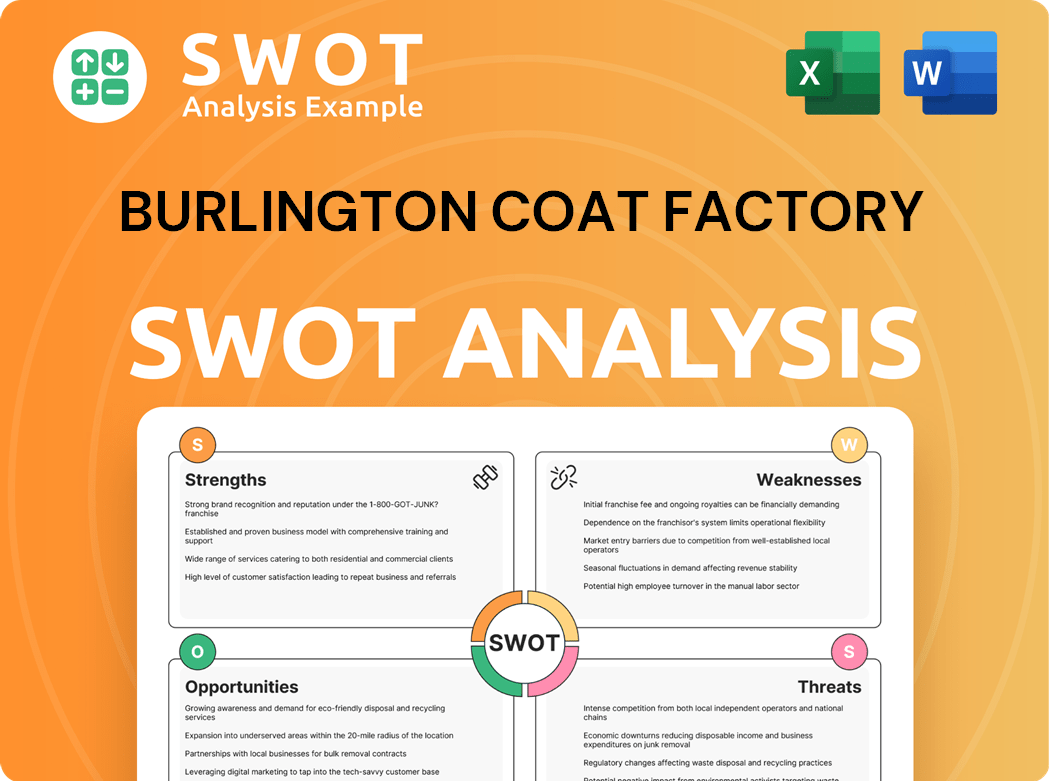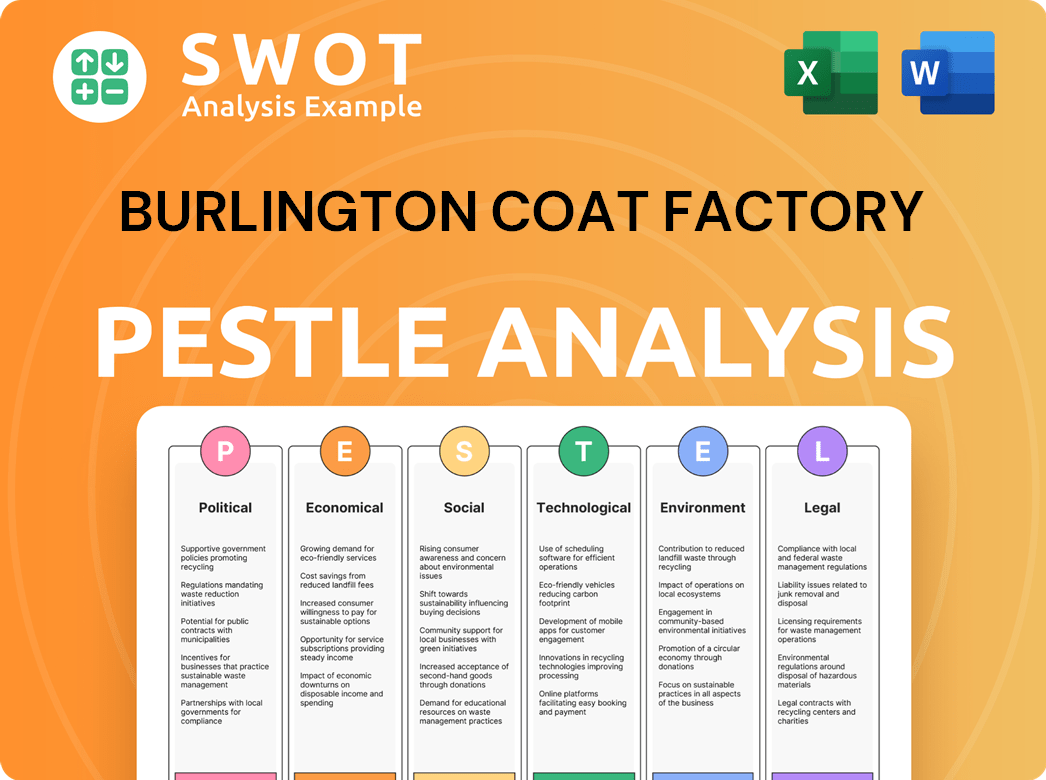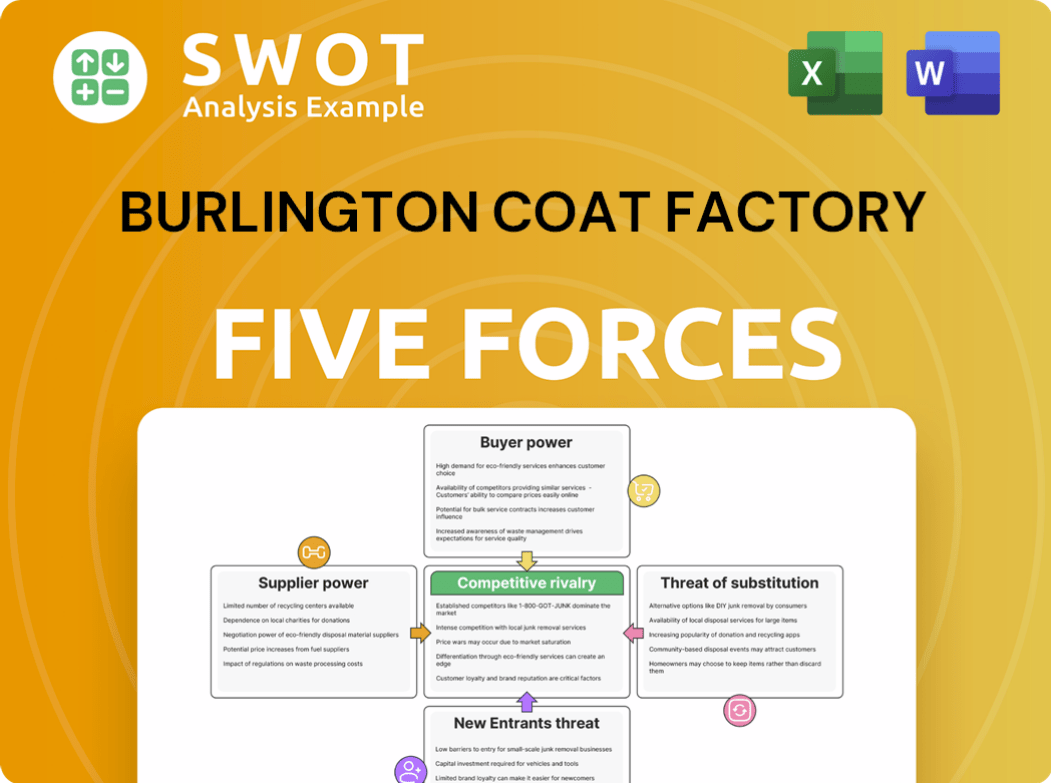Burlington Coat Factory Bundle
Can Burlington Coat Factory Thrive in Today's Retail Battleground?
Burlington Coat Factory, a cornerstone of the off-price retail industry, has built its success on offering brand-name merchandise at compelling discounts. From its humble beginnings as a coat warehouse, the company has evolved into a national powerhouse, constantly adapting to the ever-changing retail landscape. But how does Burlington stack up against its rivals, and what strategies are they employing to stay ahead?

To truly understand Burlington's position, a deep dive into its Burlington Coat Factory SWOT Analysis is essential. This analysis will help us dissect the Burlington Coat Factory competitive landscape, identify its key competitors, and evaluate its market share. Furthermore, we'll explore how Burlington navigates the off-price retail industry, focusing on retail market trends and its unique approach to discount clothing stores, providing actionable insights for investors and business strategists alike.
Where Does Burlington Coat Factory’ Stand in the Current Market?
Burlington Stores holds a strong market position within the off-price retail industry. This sector focuses on providing value-conscious consumers with discounted brand-name merchandise. The company consistently ranks among the top off-price retailers in the United States, standing alongside major competitors like TJX Companies (T.J. Maxx, Marshalls, HomeGoods) and Ross Stores. A thorough Burlington Coat Factory market analysis reveals its significant presence.
The company operates a vast network of stores across numerous states, making its discounted offerings accessible to a broad customer base. Its primary product lines include women's, men's, and children's apparel, footwear, accessories, and a growing selection of home goods. This diversified merchandise strategy allows Burlington to appeal to a wide demographic, from families seeking affordable clothing to individuals looking for discounted home decor. For a deeper dive, consider reading about the Brief History of Burlington Coat Factory.
Burlington has strategically shifted its positioning to emphasize a broader 'treasure hunt' shopping experience, moving beyond its initial focus on coats to become a more comprehensive off-price destination. This shift has helped to solidify its place in the competitive landscape. Understanding the Burlington Coat Factory competitive landscape is key to grasping its market dynamics.
Burlington consistently ranks among the top off-price retailers in the U.S. alongside TJX Companies and Ross Stores. Specific market share figures fluctuate but the company maintains a significant presence. This positions it favorably in the off-price retail industry.
Burlington operates a vast network of stores across the country, spanning numerous states. This wide geographic presence ensures accessibility for a broad customer base. The company continues to expand its store network.
The company offers a wide array of products including apparel, footwear, accessories, and home goods. This diversified merchandise strategy caters to a wide demographic. It allows Burlington to compete effectively in the discount clothing stores market.
In fiscal year 2023, Burlington reported net sales of $9.7 billion, a 7.7% increase from the previous year. The company's financial health, demonstrated by consistent revenue growth, positions it well. This shows Burlington Coat Factory financial performance.
Burlington's success is driven by its ability to offer competitive pricing and a 'treasure hunt' shopping experience. The company's business model relies on opportunistic buying and a lean operating structure. Understanding Burlington Coat Factory competitors and their strategies is crucial.
- Emphasis on value and discounted brand-name merchandise.
- Strategic store expansion, particularly in underserved markets.
- Focus on a broad range of product categories to attract a wider customer base.
- Resilience demonstrated through consistent revenue growth and profitability.
Burlington Coat Factory SWOT Analysis
- Complete SWOT Breakdown
- Fully Customizable
- Editable in Excel & Word
- Professional Formatting
- Investor-Ready Format

Who Are the Main Competitors Challenging Burlington Coat Factory?
The Burlington Coat Factory competitive landscape is shaped by a dynamic off-price retail industry. The company faces competition from a mix of direct and indirect rivals, all vying for the value-conscious consumer. Understanding these competitors is crucial for a comprehensive Burlington Coat Factory market analysis.
The off-price retail sector is characterized by its focus on offering brand-name merchandise at discounted prices. This creates a 'treasure hunt' shopping experience that attracts customers looking for deals. The Burlington Coat Factory competitors employ various strategies, including sourcing closeout merchandise and managing operational efficiencies, to maintain their competitive edge.
Burlington Coat Factory's success depends on its ability to differentiate itself through merchandise selection, pricing, and customer experience. The retail market trends, including the rise of e-commerce and changing consumer preferences, further influence the competitive environment.
The primary direct competitors include TJX Companies (T.J. Maxx, Marshalls, and HomeGoods) and Ross Stores. These companies directly compete with Burlington in the off-price retail space, offering similar merchandise at discounted prices.
TJX Companies, with its extensive store network and diverse brands, is a significant rival. Its stores offer a broad range of apparel, home goods, and accessories, often appealing to a wide demographic. In fiscal year 2024, TJX Companies reported net sales of approximately $54.2 billion.
Ross Stores is another major player in the off-price market, competing directly on price and value, particularly in apparel and home fashions. Ross Stores reported net sales of around $20.3 billion in fiscal year 2024.
Indirect competitors include department stores, mass merchandisers like Walmart and Target, and online retailers such as Amazon. These entities compete for consumer spending by offering discounted sales or competitive pricing.
Online retailers pose a continuous challenge due to their convenience and wide selection. The online retail market continues to grow, with e-commerce sales accounting for a significant portion of total retail sales. Amazon, for instance, has a vast selection of products and often offers competitive pricing.
Specialty apparel and home goods retailers also indirectly compete for consumer discretionary spending. These retailers, even at full price, can influence consumer choices. The competition also includes emerging online-only discount retailers and flash-sale sites.
The off-price retail industry is subject to constant change, with new players and shifting consumer preferences. To maintain its competitive advantage, Burlington Coat Factory must continually adapt its strategies. For more details on the company's performance and competitive positioning, you can read an article about the company's financial health and strategic moves here.
Several factors influence the competitive dynamics within the off-price retail sector. These include pricing strategies, merchandise selection, store location, and the overall customer experience. Burlington Coat Factory must excel in these areas to remain competitive.
- Pricing Strategy: Offering competitive prices and value is crucial.
- Merchandise Selection: Providing a wide variety of brand-name merchandise attracts customers.
- Store Locations: Strategic locations in high-traffic areas enhance accessibility.
- Customer Experience: Creating a positive shopping experience encourages repeat visits.
Burlington Coat Factory PESTLE Analysis
- Covers All 6 PESTLE Categories
- No Research Needed – Save Hours of Work
- Built by Experts, Trusted by Consultants
- Instant Download, Ready to Use
- 100% Editable, Fully Customizable

What Gives Burlington Coat Factory a Competitive Edge Over Its Rivals?
Understanding the Burlington Coat Factory competitive landscape requires a deep dive into its strategic advantages. The off-price retail industry is fiercely competitive, and Burlington has carved a niche through a combination of smart sourcing, efficient operations, and a strong brand presence. This allows it to offer significant discounts, attracting value-conscious consumers and driving consistent foot traffic to its stores.
The company's success is built on several key pillars. Its ability to secure brand-name merchandise at reduced prices is a cornerstone of its business model. This, combined with a wide physical footprint and efficient inventory management, allows Burlington to maintain profitability in a low-margin environment. A closer look at its strategies reveals how it navigates the retail market trends and maintains its position among Burlington Coat Factory competitors.
Burlington's competitive strengths are crucial for its long-term success. While the off-price retail industry is always evolving, Burlington's focus on value, operational efficiency, and customer experience positions it well to adapt and thrive. Analyzing these advantages provides a comprehensive view of its market position and potential for future growth.
Burlington excels at acquiring excess inventory and closeout merchandise from manufacturers. This strategy allows them to offer brand-name products at discounts, often 60% or more below department store prices. This approach creates a 'treasure hunt' experience that encourages frequent customer visits and impulse purchases, driving sales and customer loyalty.
With hundreds of stores across the United States, Burlington provides convenient access for a broad customer base. This physical presence, combined with a focus on in-store experience, differentiates it from purely online retailers. The company has been strategically optimizing its store formats, opening smaller, more efficient stores to improve profitability and reach new markets.
Burlington benefits from strong vendor relationships cultivated over decades. These relationships are crucial for securing desirable brand-name merchandise at favorable prices. Efficient supply chain and logistics capabilities contribute to its competitive edge, allowing for rapid inventory turnover and effective distribution of merchandise to stores. These relationships are key to maintaining a steady stream of discounted products.
Burlington's operational efficiencies and disciplined inventory management are critical to its profitability in the low-margin off-price business. The company focuses on rapid inventory turnover and effective distribution. These efficiencies allow Burlington to maintain competitive pricing and manage costs effectively.
Burlington's competitive advantages include its opportunistic buying model, extensive store network, and efficient operations. These factors enable the company to offer compelling value to customers and maintain a strong market position. The company's ability to adapt to retail market trends and maintain strong vendor partnerships is essential for its continued success.
- Opportunistic Buying: This allows Burlington to acquire merchandise at significant discounts.
- Extensive Store Network: Provides convenient access for a wide customer base.
- Efficient Operations: Supports rapid inventory turnover and cost management.
- Strong Vendor Relationships: Secures access to desirable brand-name merchandise.
Burlington Coat Factory Business Model Canvas
- Complete 9-Block Business Model Canvas
- Effortlessly Communicate Your Business Strategy
- Investor-Ready BMC Format
- 100% Editable and Customizable
- Clear and Structured Layout

What Industry Trends Are Reshaping Burlington Coat Factory’s Competitive Landscape?
The Burlington Coat Factory competitive landscape is shaped by the dynamic off-price retail industry. The company's success hinges on navigating market trends, addressing challenges, and capitalizing on emerging opportunities. Understanding the industry dynamics, including consumer behavior and technological advancements, is crucial for strategic decision-making.
The Burlington Coat Factory market analysis reveals a focus on value and convenience. The company's ability to adapt to changing consumer preferences, such as the increasing demand for online shopping, will be critical for its future performance. This involves strategic adjustments to maintain competitiveness and drive growth within the retail sector.
The off-price retail industry is experiencing sustained consumer demand for value, especially with economic uncertainties. This drives competition as retailers use promotions. The shift towards omnichannel retail impacts all players, requiring integration of online and physical shopping experiences.
Maintaining strong vendor relationships amidst rising competition is a key challenge. Managing increasing operational costs and adapting to evolving consumer preferences are also significant. Economic downturns could affect discretionary spending, though off-price retailers often perform well during these times.
Opportunities include expanding through new store openings, particularly in underserved markets and smaller formats. Diversifying merchandise categories, such as home goods, can attract new customers. Strategic investments in data analytics can improve inventory planning and customer insights.
Strategic agility in buying and adapting the store experience is essential. Building a strong online presence could be a key to future success. The company's financial position supports investment in growth initiatives. Understanding the Burlington Coat Factory competitors is essential.
The ability of Burlington Coat Factory to adapt to these trends will significantly influence its future performance. The company's focus on value and convenience, as highlighted in the Revenue Streams & Business Model of Burlington Coat Factory article, positions it to capitalize on opportunities. The company needs to strategically navigate challenges to maintain its competitive edge.
The off-price retail sector's future depends on adapting to consumer needs and market dynamics. Burlington Coat Factory market share analysis shows the importance of expansion and diversification. Strategic investments in technology and understanding consumer behavior will be crucial for success.
- Focus on value will drive the discount clothing stores segment.
- Expansion and new store formats are essential for growth.
- Data analytics and supply chain optimization are key areas for investment.
- Adapting to omnichannel retail is vital to stay competitive.
Burlington Coat Factory Porter's Five Forces Analysis
- Covers All 5 Competitive Forces in Detail
- Structured for Consultants, Students, and Founders
- 100% Editable in Microsoft Word & Excel
- Instant Digital Download – Use Immediately
- Compatible with Mac & PC – Fully Unlocked

Related Blogs
- What are Mission Vision & Core Values of Burlington Coat Factory Company?
- What is Growth Strategy and Future Prospects of Burlington Coat Factory Company?
- How Does Burlington Coat Factory Company Work?
- What is Sales and Marketing Strategy of Burlington Coat Factory Company?
- What is Brief History of Burlington Coat Factory Company?
- Who Owns Burlington Coat Factory Company?
- What is Customer Demographics and Target Market of Burlington Coat Factory Company?
Disclaimer
All information, articles, and product details provided on this website are for general informational and educational purposes only. We do not claim any ownership over, nor do we intend to infringe upon, any trademarks, copyrights, logos, brand names, or other intellectual property mentioned or depicted on this site. Such intellectual property remains the property of its respective owners, and any references here are made solely for identification or informational purposes, without implying any affiliation, endorsement, or partnership.
We make no representations or warranties, express or implied, regarding the accuracy, completeness, or suitability of any content or products presented. Nothing on this website should be construed as legal, tax, investment, financial, medical, or other professional advice. In addition, no part of this site—including articles or product references—constitutes a solicitation, recommendation, endorsement, advertisement, or offer to buy or sell any securities, franchises, or other financial instruments, particularly in jurisdictions where such activity would be unlawful.
All content is of a general nature and may not address the specific circumstances of any individual or entity. It is not a substitute for professional advice or services. Any actions you take based on the information provided here are strictly at your own risk. You accept full responsibility for any decisions or outcomes arising from your use of this website and agree to release us from any liability in connection with your use of, or reliance upon, the content or products found herein.